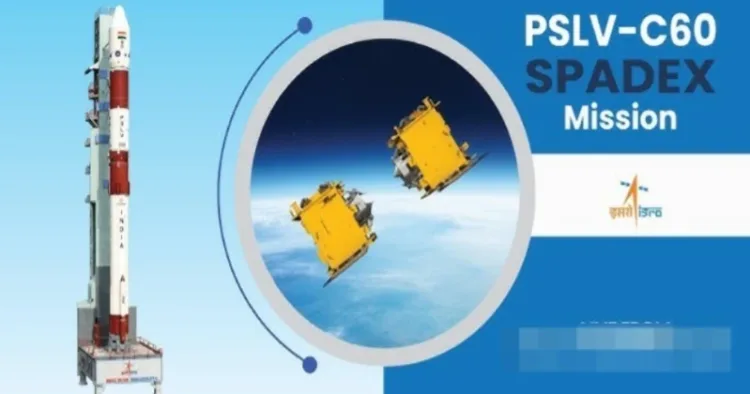The Indian Space Research Organisation (ISRO) successfully launched its year-end mission, the “Space Docking Experiment” (SpaDeX), on December 30, said the organisation. The mission was launched precisely at 10:00:15 pm from the Satish Dhawan Space Centre in Sriharikota, Andhra Pradesh.
🚀 LIFTOFF! 🌠
PSLV-C60 successfully launches SpaDeX and 24 payloads.
Stay tuned for updates!
🎥 Watch live: https://t.co/D1T5YDD2OT
📖 More info: https://t.co/jQEnGi3W2d#ISRO #SpaDeX
— ISRO (@isro) December 30, 2024
The first stage performance is normal. SpaDeX mission is a cost-effective technology demonstrator mission for the demonstration of in-space docking using two small spacecraft launched by PSLV. The primary objective of the SpaDeX mission is to develop and demonstrate the technology needed for rendezvous, docking, and undocking of two small spacecraft (SDX01, which is the Chaser, and SDX02, the Target, nominally) in a low-Earth circular orbit.
The technological challenge has been mastered only by a few countries and the indigenous technology used for this mission is called the “Bharatiya Docking System”.
“The success of this mission is vital for India’s future space ambitions,” Science and Technology Minister Jitendra Singh had said earlier.
Docking technology is key for long-term missions like “Chandrayaan-4” and the planned Indian space station. It is also crucial for the eventual manned “Gaganyaan” mission.
The PSLV-C60 rocket was launched from the Satish Dhawan Space Centre in Sriharikota, Andhra Pradesh on December 30.
Preparations were made to launch the PSLV-C60 rocket. ISRO was ready with all the arrangements. For the ‘Spatial’ project, launched two small spacecraft, ISRO made all the arrangements to launch the PSLV-C60 rocket from the Sriharikota launch pad.
The “Space Docking Experiment” (SpaDeX) mission used the PSLV-C60 rocket.
As per the ISRO, the primary objective of the SpaDeX mission is to develop and demonstrate the technology needed for rendezvous, docking, and undocking of two small spacecraft (SDX01, which is the Chaser, and SDX02, the Target, nominally) in a low-Earth circular orbit.
“In addition, SpaDeX, because of its small size and mass, is even more challenging due to the finer precision required for the rendezvous and docking maneuvers compared to docking two large spacecraft. This mission will be a forerunner for autonomous docking needed for future lunar missions like Chandrayaan-4 without the support of GNSS from Earth,” ISRO said in a statement.
Like all ISRO satellites in low-Earth orbit, both the SpaDeX spacecraft carry a differential GNSS-based Satellite Positioning System (SPS), which provides PNT (Position, Navigation, and Timing) solutions for the satellites.
“In SpaDeX, a novel RODP processor is included in the SPS receiver, which allows accurate determination of the relative position and velocity of the Chaser and the Target. By subtracting the carrier phase measurements from the same GNSS satellites in both Chaser and Target SPS receivers, highly accurate relative states of the two satellites are determined. The VHF/UHF transceivers in both satellites aid this process by transferring the GNSS satellite measurements from one satellite to the other. Hardware and software test beds, including closed-loop verifications, were carried out to characterise the RODP performance,” the statement said.
The SpaDeX spacecraft were designed and realised by the UR Rao Satellite Centre (URSC) with the support of other ISRO centers (VSSC, LPSC, SAC, IISU, and LEOS). The spacecraft, in its orbital phase, will be controlled from ISTRAC using ISRO ground stations and other externally hired ground stations.
The mission will also test advanced payloads, including high-resolution cameras and multi-spectral imaging tools for earth observation and radiation monitoring. Post-docking, both satellites will operate independently for a mission life of two years. This ambitious project, developed at ISRO’s UR Rao Satellite Centre, marks a significant milestone in India’s space capabilities, paving the way for future human and robotic space missions.



















Comments